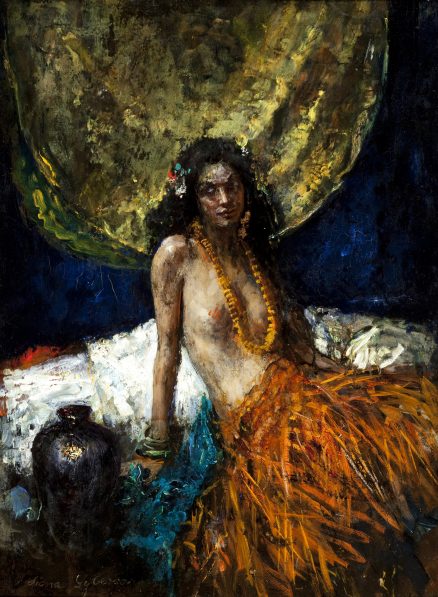- Categories
- Figural works
- Women
- Women artists
- Zoom in on Artwork
- Print Page
- Email Page to Friend
Indiana Gyberson’s image of a young woman in a grass skirt seductively posed against a vivid blue, white, and gold background is one of several images she painted of “hula girls” positioned among exotic objects. Bare-breasted beneath a flower lei, the seated model strikes a languid pose as she glances to the side. Her mass of loose dark hair enlivened with bright ornaments is set against the shimmering, uneven surface of the gold drapery in the background. At the lower left stands a tall ceramic jar with a dark reflective surface. Thick, heavily worked pigment across the painting’s surface creates a rich effect that complements the image’s evocation of oriental luxury.
The exotic women and objects Gyberson painted reflect her era’s fascination with so-called primitivism, particularly as associated with the remote South Seas. Performance exhibits at the 1915 Panama-Pacific International Exposition in San Francisco launched a national craze for the indigenous music and dance of Hawaii, including its tradition of hula. French artist Paul Gauguin had earlier used the inspiration of an exotic Pacific culture to explore formal modernism, but Gyberson instead drew on the conventions of the studio-composed still life and a penumbra of rich, shadowy tones to emphasize the foreignness of her dark-skinned, exotically dressed models. Reviewers found her approach itself seductive. One observed that “her pictures have the dramatic quality of nightborn thoughts . . . . A shadowy feeling pervades them and yet they impress one as being brilliant in color.”i The jewel-like effect of paintings such as Hula Girl is enhanced by their relatively small scale: in intimate proximity they function, like the women they picture, as exquisite decorative objects.
Wendy Greenhouse, PhD
Donated by M. Christine Schwartz to the Illinois State Museum, Springfield, Illinois, in 2021
i Evelyn Marie Stuart, “Chicago Artists’ Twenty-Second Annual Exhibition,” Fine Arts Journal 36 (Mar. 1918): 7.
